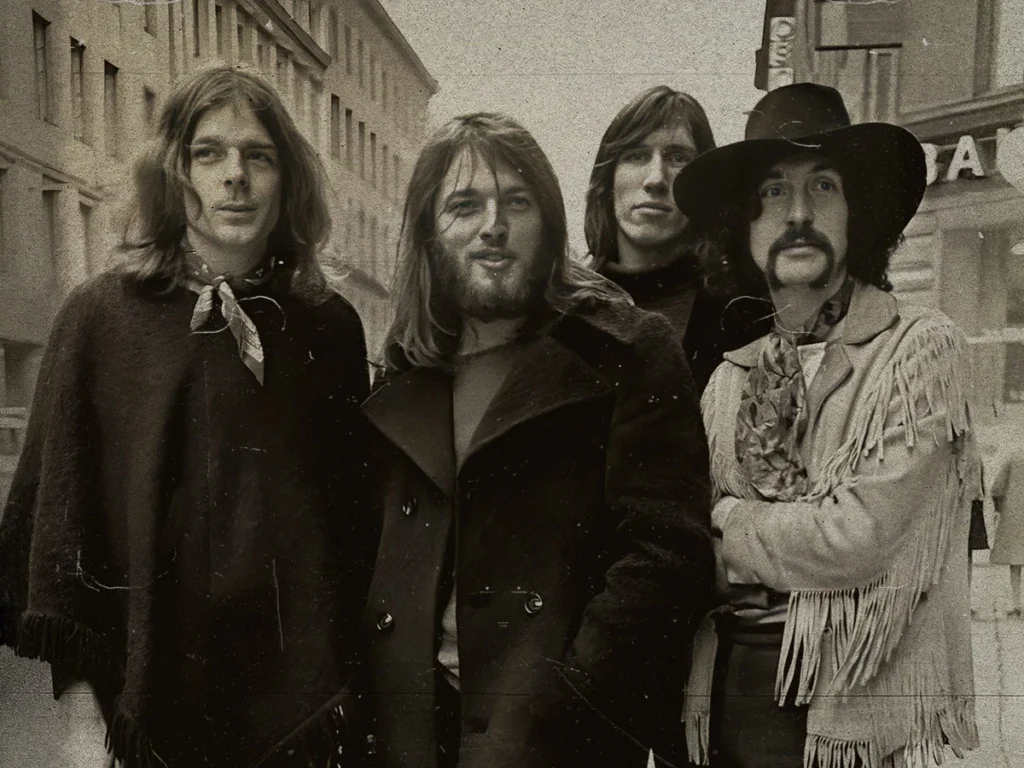Released in 1977, Pink Floyd’s “Animals” stands as a formidable edifice within the band’s monumental discography. This album, arriving between the plaintive “Wish You Were Here” (1975) and the narrative-driven “The Wall” (1979), marks a distinct turn towards a more cynical and acerbic sonic and thematic landscape. Unlike its predecessors, which delved deeply into personal strife and existential disillusionment, “Animals” is both a continuation and a stark deviation, immersing itself in the socio-political commentary that was only hinted at in earlier works.
Artistic Intentions
“Animals” is loosely modeled on George Orwell’s allegorical novella “Animal Farm”, transforming its critique of totalitarianism into a scathing portrait of capitalist society. The album’s artistic vision is profoundly ambitious, leveraging a narrative structure that divides humanity into three metaphorical classes: dogs, pigs, and sheep. This framework serves not only to explore societal roles but also to challenge and satirize the dehumanizing forces at play within them.
Roger Waters, the band’s bassist and primary lyricist during this period, infused “Animals” with a sharp, observant eye, aiming to dismantle the façades of socio-economic constructs. The thematic departure is underscored by the intense, brooding instrumentals that mirror the album’s somber reflections on greed, corruption, and alienation. Thus, while it deepens the band’s earlier explorations of alienation and despair, “Animals” also carves out new auditory and conceptual territory, signaling a band that is unafraid to confront discomforting truths about society through the powerful medium of progressive rock.
In crafting “Animals”, Pink Floyd not only challenged their audience but also expanded the possibilities of what a rock album could convey about the world. This record is a daring interrogation of the human condition, making it one of the most provocative entries in Pink Floyd’s oeuvre. As such, “Animals” not only reflects its time but also transcends it, offering insights that remain piercingly relevant in today’s socio-political climate.
Sonic Exploration

The production of Pink Floyd’s “Animals” is a masterclass in sonic architecture, characterized by a crisp and immersive sound that envelops the listener. Engineered primarily by Roger Waters and produced in the band’s own Britannia Row Studios, the album’s production quality stands out in the way it captures the raw intensity and expansive dynamics of the arrangements. The clarity of the production serves to enhance the thematic depth of the album, enabling each note to carry the weight of the societal critique embedded within.
Musical Arrangements
Musically, “Animals” is structured around three lengthy compositions that are bridged by shorter acoustic pieces. The arrangements are meticulously crafted, featuring a complex interplay of David Gilmour’s guitar, which ranges from ferocious riffs to haunting solos, and Richard Wright’s atmospheric keyboard work. Notably, the album eschews conventional verse-chorus structures in favor of these expansive compositions that evolve in progressive stages. The vocals, primarily handled by Waters, are delivered with a biting intensity that complements the dark narrative themes. The innovative use of synthesizers and sound effects adds layers of depth, creating a soundscape that mirrors the bleak societal landscape the album depicts.
Genre Elements
In terms of genre, “Animals” is firmly rooted in progressive rock, yet it incorporates elements of hard rock and art rock. This amalgamation supports the album’s complex thematic and musical narratives, allowing for a broader exploration of sound and meaning. The use of acoustic elements juxtaposed with heavy electric sections creates a dynamic tension within the album, reflecting the societal tensions addressed in the lyrics. This blend of genres not only underscores the album’s emotive force but also showcases Pink Floyd’s ability to transcend traditional musical boundaries, making “Animals” a seminal work in the progressive rock genre.
Lyrical Analysis

The lyrical tapestry of Pink Floyd’s “Animals” is rich with thematic complexity and emotional depth, making it one of the most intellectually and emotionally compelling albums in their discography. The central themes revolve around societal decay, moral corruption, and the dehumanizing aspects of capitalist society, drawing heavily on the allegorical structure inspired by George Orwell’s “Animal Farm”. The album segments society into three groups—dogs, pigs, and sheep—each symbolizing different social classes and behaviors that critique the ruthlessness and manipulativeness inherent in the capitalist structures.
Lyrically, Roger Waters employs a mix of direct narrative and abstract symbolism. The lyrics are not merely descriptive; they are imbued with a poetic intensity that requires contemplation. For instance, in “Dogs”, the lyric “You have to be trusted by the people that you lie to, so that when they turn their backs on you, you’ll get the chance to put the knife in” is both a direct accusation and a metaphor for betrayal and exploitation in business and personal relationships. This blend of straightforward narrative and metaphor allows the album to be both accessible and richly layered, offering new insights upon each listen.
Emotional Impact
The emotional impact of the album is profound, as the lyrics paint a grim picture of alienation and despair, yet also call for a critical reflection on one’s place within societal structures. The use of recurring motifs like the dogs, pigs, and sheep provides a cohesive narrative thread that emphasizes the cyclical nature of power and submission in society. The album’s closing track, “Pigs on the Wing 2”, suggests a glimmer of hope through personal connection, a stark contrast to the isolation and cynicism that pervade the rest of the album. This juxtaposition enhances the emotional resonance of the album, leaving the listener with a sense of melancholic contemplation mixed with a cautious optimism.
Cohesion & Flow

The architecture of “Animals” demonstrates an exemplary sense of cohesion and narrative flow that is critical to its profound impact. Pink Floyd structured the album with a clear intention of weaving a continuous thematic and emotional narrative across its tracks, despite its relatively sparse five-song tracklist.
Track progression in “Animals” is meticulously crafted, beginning with “Pigs on the Wing 1” and closing with “Pigs on the Wing 2”. These two acoustic bookends serve as both an introduction and a conclusion to the societal critique that unfolds in the three central tracks: “Dogs”, “Pigs (Three Different Ones)”, and “Sheep”. This structure creates an envelope effect, which encapsulates the harsher, more expansive central pieces with a more intimate, personal reflection on human relationships. This progression provides not only a narrative but an emotional arc, as the album moves through a spectrum of disillusionment and critique before returning to a note of personal connection and potential redemption.
Thematic Consistency
Thematic consistency is maintained with remarkable precision throughout “Animals”. The themes of societal decay and personal alienation are explored consistently in both lyrics and music. Musically, the album maintains a dark, brooding energy that mirrors its lyrical content. The extensive use of synthesizers, guitars, and complex arrangements in “Dogs”, “Pigs (Three Different Ones)”, and “Sheep” convey a sense of foreboding and introspection, while the acoustic simplicity of the “Pigs on the Wing” parts contrasts with and highlights the emotional and thematic depth of the central tracks.
There are no jarring shifts in the album; even the transitions between the fiercely critical “Dogs” and the bitterly satirical “Pigs (Three Different Ones)” are handled with a smoothness that underscores the album’s overall narrative. This seamless flow enhances the listener’s immersion, making the album not just a collection of songs but a unified statement with a beginning, middle, and end.
Standout Tracks & Memorable Moments

While each track on Pink Floyd’s “Animals” contributes significantly to the album’s overarching critique of societal mechanisms, certain pieces and moments within them stand out for their artistic and emotional profundity.
Key Tracks
“Dogs”: As one of the album’s central pieces, “Dogs” stands out for both its length and its depth. Clocking in at over seventeen minutes, the track is a tour de force of progressive rock instrumentation and lyrical depth. The song’s exploration of cutthroat corporate and personal politics is matched by its musical complexity, featuring an array of guitar solos by David Gilmour that are among the most emotionally resonant and technically proficient in the band’s repertoire. The transitions between acoustic softness and electric aggression within this track make it a cornerstone of the album’s thematic and emotional expression.
“Pigs (Three Different Ones)”: This track is notable for its biting satire aimed at the moral and ethical decay of societal leaders. Roger Waters’ vocal delivery—sardonic and accusatory—complements the gritty, funk-infused basslines and scathing lyrics. The use of a talk box on Gilmour’s guitar provides a sonic representation of the mocking voice that Waters lends to the ‘pigs’ of society, enhancing the track’s cutting commentary.
Memorable Moments
Guitar Solos in “Dogs”: Particularly memorable is the series of guitar solos that bridge the lengthy “Dogs”. Gilmour’s ability to convey complex emotions through his instrument reaches a peak here, with solos that intertwine seamlessly with Wright’s synthesizers, creating a sense of escalating tension and release that mirrors the track’s thematic exploration of betrayal and survival.
Sheep’s Synth Transformation: In “Sheep”, there is a pivotal moment where the mood shifts dramatically through the use of a synthesizer sequence that reinterprets Psalm 23, twisting this traditionally comforting scripture into a dystopian vision. This powerful and unsettling transformation not only highlights Wright’s skill and creativity but also serves as a stark reminder of the album’s critique of blind obedience and manipulation.
Closing Harmony in “Pigs on the Wing 2”: The album closes with “Pigs on the Wing 2”, where the return to an acoustic, more intimate setting serves as a poignant counterbalance to the dense and dark content of the middle tracks. The harmony sung here offers a brief, yet profound sense of hope and connection, a reminder that individual relationships can offer solace from the societal machines at play.
These standout tracks and moments are integral to “Animals”, making it a deeply engaging and thought-provoking album. They showcase Pink Floyd’s ability to blend incisive lyrics with innovative music, creating an enduring work that resonates with listeners long after the final note has faded.
Artistic Contributions & Innovation

“Animals” holds a distinctive place not only within Pink Floyd’s oeuvre but also within the broader context of rock music, particularly within the progressive rock genre. The album is a remarkable example of boundary-pushing both in terms of its thematic content and its sonic execution, ensuring its enduring relevance and influence.
Place in Genre/Industry
In the late 1970s, the music industry was experiencing significant shifts with the rise of punk rock and disco, challenging the dominance of progressive rock’s more elaborate and polished productions. “Animals,” with its dark, complex narratives and elaborate compositions, both contrasted with the simplicity and rawness of punk and reaffirmed the artistic depth that progressive rock could offer. The album’s unflinching critique of societal structures and its exploration of human psychology placed it at the forefront of conceptual rock albums, helping to shape the trajectory of progressive music with its bold, thematic ambitions.
Innovation
Thematic Depth and Narrative Structure: “Animals” was particularly innovative in how it integrated a cohesive, Orwellian-inspired narrative into the fabric of a rock album. This approach was not entirely new for Pink Floyd, but “Animals” deepened this narrative style by offering a stark, allegorical critique that was more overtly socio-political than their previous albums. The use of distinct animal metaphors to represent societal classes and behaviors was a fresh take on rock lyricism, providing a dense, layered experience that encouraged deeper engagement from the audience.
Musical Arrangement and Production Techniques: The album’s sound is marked by its experimental approach to production and arrangement. The extensive use of the guitar synthesizer by David Gilmour was innovative for the time, allowing for a wider range of sounds and textures that enhanced the thematic weight of the songs. Richard Wright’s pioneering use of the Minimoog and ARP String Synthesizer pushed the boundaries of electronic music within a rock framework, adding a futuristic yet deeply unsettling layer to the album’s atmosphere.
Integration of Acoustic and Electric Elements: The juxtaposition of harsh electric textures with softer, acoustic moments in “Animals” was a deliberate choice that highlighted the album’s dramatic thematic shifts. This blend not only showcased Pink Floyd’s musical versatility but also mirrored the album’s exploration of external societal facades versus internal human realities.
Final Thoughts

“Animals” stands as a towering achievement in Pink Floyd’s discography and within the broader landscape of progressive rock. Its strengths are manifold, from the intricate and innovative musical arrangements to the profound thematic depth. The album excels in merging complex narrative content with pioneering soundscapes, making it a compelling and challenging listen. The raw and unfiltered socio-political commentary presented through a sophisticated allegory distinguishes “Animals” as one of the band’s most ambitious and significant releases.
The strengths of the album are its cohesive thematic exploration and the musical execution that supports it. The tracks are not only sonically rich but also intellectually stimulating, provoking thought and discussion on the human condition within societal structures. The production quality and the meticulous attention to musical detail allow each song to convey its message powerfully and poignantly.
If there are weaknesses, they might only be perceived in terms of the album’s accessibility. The dense thematic elements and the extended instrumental passages might challenge casual listeners. However, these same qualities are what many critics and fans celebrate, marking “Animals” as a work that rewards deep and repeated listenings.
Official Rating
Given these considerations, “Animals” is undeniably deserving of a 10 out of 10 rating. This score reflects not just the album’s technical excellence and innovative approach, but also its enduring impact on music and culture. “Animals” pushes listeners to confront uncomfortable truths about society and themselves, making it a profound listening experience that resonates across decades. In Pink Floyd’s career, it represents a bold exploration of new thematic territory and musical styles, cementing their status as pioneers of the progressive rock genre.
